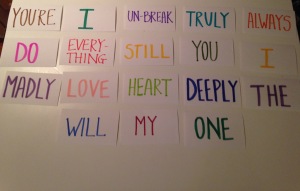In the past couple of months I’ve settled into a bit of a rhythm with my group sessions at the developmental disabilities agency. The clients who participate in music therapy choose to do so each week by signing up the day before. They are free to attend every week but they aren’t required to. I’ve received approximately 50 “regular” clients who rotate in and out every couple of weeks. Each group consists of 15 people so I always have a different assortment of individuals who attend, but each face is now familiar. These clients have gotten to know me and have learned what to expect each week as far as the structure of the session. What this means to me is that I need to continue to create new intervention ideas and ways to keep each session exciting and unpredictable (in a predictable way). Below are some examples of interventions I’ve done in the last couple of months that have been extremely successful and for which the clients have shown great enthusiasm.
*These interventions are designed for adults with intellectual and developmental disabilities.
INTERVENTION RESOURCE #4
“Guess Who Sang THIS Song“
Goals: Impulse control, social skills; awareness
Intervention: This is very straightforward, jeopardy-style game. The object is to have clients correctly identify a song title or artist by raising their hand. Play a clip of the song either recorded or live and choose someone to answer what the song is or who sang it.
Considerations: Reminding the clients before, and continually during the game, to not shout out answers, but to raise their hand to share. When the clients are extremely excited to answer they typically lose their impulse control. I generally call on someone who hasn’t revealed the answer out loud and followed directions.
Adaptations: I have adapted this game for various session themes. One way to alter this is by playing recorded clips of the music and having the words of the song title written out on notecards, scrambled up, and posted on a board. This allows you to use more thematic music for your session without relying on whether the clients can recall the title without prompts. You can then use music that is familiar to most and have them join in singing along to help unscramble the song title from the lyrics.

INTERVENTION RESOURCE #5
“Creating a ‘Band’“
Goals: Gross motor movement, attention, following directions, working together
Intervention: I asked the group to imagine that we had formed a band and each small group (approx. 3 people) was a section of the band. We were about to have band practice to learn and rehearse a new song before we performed it.
Pick a song in which you can choose repetitive words to assign to a small “section” of the “band”. I used a poster board with the selected words as a visual, but set up each section to play around the circle so that when I stood in front of them, it helped remind them it was their turn to play. We “learned”, “rehearsed”, and “performed” this song; each time improving their ability to play together, wait their turn, and follow cues.
Adaptations: The first week we did this, it was for our 1980’s themed session. I chose “Jitterbug” by Wham!. I LOVE this song for the purpose of the many onomatopoeias. I selected instruments that reflected these onomatopoeias and assigned the instruments and words to each “band section”. We did only the first verse, and chorus (live music). My instrumentation looked like this: “Boom Boom“: Drums; “Bang, Bang, Bang“: Tambourine “Jitterbug“: Kokirko, Cabasa, Seed Rattle; “Go-Go“: Rhythm Sticks; “Yo-Yo”: Handbells AND a slide whistle; “High”: (everyone plays).
This song was SO fun and worked SO well I regret every day since that I didn’t get it on video. I can’t wait to do it again!

INTERVENTION RESOURCE #6
“Simple Drum Circle (With Rhythm Sticks)“
Goals: Following directions/cues, working together, attention, gross motor movement
Intervention: I found two basic drum circle ideas from this blog post on Pinterest. I needed to find something that was simple enough for my clients but still challenged them to work on their goals. One idea was to assign everyone a number (1-8) and play their drum (rhythm sticks) in tempo on their number. Simply count to 8 a few times. This is challenging for them because the idea of more than one person being assigned to “number one” is abstract, so we worked on this a few times around.
The second drum circle idea is in basic follow-the-leader style. Simply have the clients “rumble” their sticks when you rumble. Move up and down to signal dynamic changes and have them end each rumble with a “clap” of their sticks. Having them change dynamic levels and start/stop together was an awesome example of attention and following directions. They loved it!
Adaptations: Obviously, I adapted the drum circle to using rhythmic sticks due to my short supply of drums and extensive supply of rhythmic sticks. I use a tubano as the drum circle leader to help with the balance of leader to group sound. Even though they aren’t playing drums, they are still always excited to participate in the drum circle.
On to creating more interventions! I hope these examples offer original adaptions to others or inspire new ideas.
Leave a comment